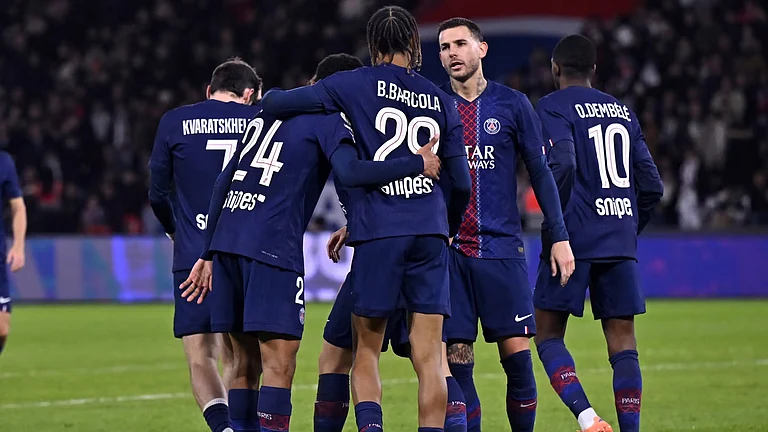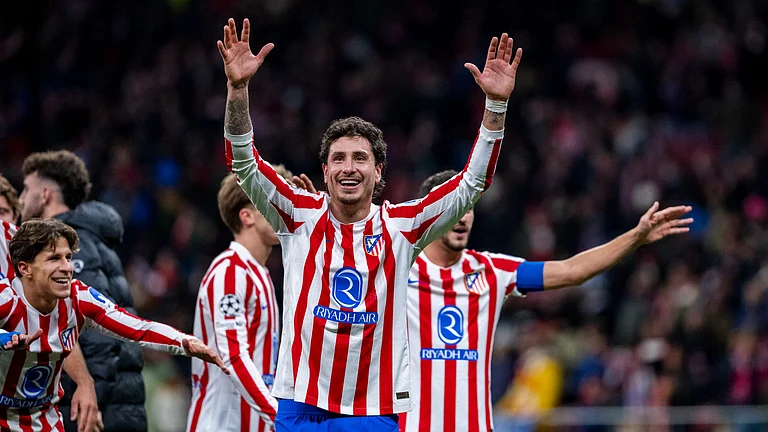IT is all part of a jigsaw that fits the familiar image of a bombed town—collapsed roofs, cracked walls, mangled pipelines, broken electric poles, uprooted trees, fissured roads. But unlike Kosovo, the district town of Chamoli was pounded from below. By a tectonic time-bomb that had been ticking away for God knows how long. A catharsis of catastrophic effect, measuring 6.8 on the Richter scale, shook the entire Garhwal region. As people slept, their houses crashed down, killing over 100 and injuring four times as many. The shock waves travelled as far as Delhi, where people were jolted into wakefulness by swinging fans, clanging utensils, shuddering beds and barking dogs.
The images are stark and traumatic. In Chamoli, a mother and her two daughters rummage among the remains of their collapsed house. A little girl carries her injured dog in her lap. People mistake scribes for government officials, pointing out their damaged houses and imploring them to take a visual testimony. Bhagat Singh Bisht, sheltered in a makeshift tent with his family, stares haplessly at the rubble of his house. He points out a window—over 8 ft high and just large enough to let in a small dog—though which he escaped with his wife and two small kids. "But I couldn't save my eldest daughter and my mother," he mourns. The only earning member of the family, he has no idea how he is going to cope. A man complains that his cattle are buried under his house. "It's beginning to stink and there's no one to help me extricate them," he says.
The injured are being nursed at a hospital in Gopeshwar, 8 km away. A little girl, cradled in her mother's lap, suddenly has a fit. "She is still under shock," the doctor explains. Four convalescing prisoners recount their harrowing experience the night of the quake. "There were 17 of us in the lock-up. There were no constables around and the key to the lock-up was with the jail warden a kilometre away. As the roof started collapsing on us, we cried for help. But no one came. I was lucky to be near the door when the roof caved in. We were finally rescued by two fellow prisoners, Satinder and Vishal, who had managed to escape," says Ram Sauri. Five prisoners, however, were crushed to death.
Outside, oblivious of the prisoners' travails, residents of Gopeshwar queue up for buckets of water. Due to the damaged water pipes, the area is dependent on rations from the water tankers.
Jagdamba Prasad Hatwal, deputy prad-han of village Haat, has just brought in an injured couple from his village. "They were trapped in the rubble for four hours," he says. He is angry that everybody, including the media, is obsessed with Chamoli town. "There are many villages in Chamoli and Rudraprayag districts that were devastated, but nobody is visiting them," he says. Several villagers from these areas were in Chamoli town exhorting scribes and offi-cials to visit their villages too.
Hatwal is right. Chamoli is teeming with scribes and officials. Everybody is waiting for Chief Minister Kalyan Singh to arrive. When he finally does, it is with cavalcade and a hovering chopper. He takes a cursory 10-minute round of the affected houses, promises relief to the victims and leaves amid much official bustle. Suddenly the town looks deserted, the victims are left brooding over their misfortune.
IN all this, real questions are brushed under the carpet. How long will relief be provided to the victims? How soon will the compensation be disbursed? In what ways can victims be rehabilitated? Is it enough to reimburse their losses with money? Or should the state educate them on how to avert and cope with such disasters? "This is what disaster management is all about. It's a shame that despite being one of the most disaster-ravaged nations in the world, we still do not have a disaster management policy. Last year's floods and landslides amply demonstrated how myopic and ill-prepared we are in dealing with big disasters," says K. Unnikrishnan of OXFAM. And this year around, the state of unpreparedness hasn't changed.
Kyonja, Makku, Parkendi, Jalai, Akhori, Kansil, Kontha—these quake-affected villages in Rudraprayag district have been shut out of public consciousness because of landslides. It is possible to trek to these villages. But few have taken up the challenge.
Kyonja is about two hours away. It's a steep climb for the first hour. A young teenage boy ferries a full gas cylinder on his not-so-broad but surely strong shoulders from Kyonja to Chandrapuri, the nearest town that can be reached by pucca road at present. "My house has been destroyed, so we're transferring all our things to Chandrapuri," he says. En route, villagers complain that no official has visited them so far.
A kilometre short of Kyonja, three women and a small boy are carrying an injured old woman on a cot. "She was visiting her family when the quake occurred. We're now carrying her to Chandrapuri," the boy volunteers. Will they carry her all the way down? "Yes," he answers, older than his years.
Kyonja is in ruins. Eight people have perished in the quake. And many injured. Almost every house has been damaged beyond repair, with large cracks yawning from the walls. Women can be seen cooking out in the open. There are four tents under which men, women, and children are sprawled, despair writ on their faces. "We dare not venture inside our houses for the tremors haven't died down," says one. All of them are sleeping out at night.
Roshan Lal, 27, lost his sister-in-law and niece in the quake. His brother, badly injured, is hospitalised. He wants to know if his family will be compensated. By his side stands Darshan Lal, 35, who according to the surrounding crowd, is their "hero". Lal relates how on that ill-fated night he, along with a few young boys, went from home to home listening for voices of people trapped underground. "We must have rescued at least 15," he says, no trace of pride in his voice.
There is sorrow, misery and despair. And also, individual acts of heroism. But mostly, there is a sense of outrage at official callousness. It's been over two days and no official has visited, no relief has reached, complain the people of Kyonja. Back in Rudraprayag, officials claim relief operations are proceeding apace in almost all villages.
It's the same old story. A disaster happens, the government has little clue how to deal with it, it covers up its inefficiency, announces compensations, and soon everybody forgets about it. Over to the next disaster, please.
IF the state can't manage disasters, it's too much to expect that it could think of averting them. "Instead of spending crores in relief operations, it makes more sense to identify quake-prone areas and make buildings that can resist the impact," says Bhawani Singh, a structural engineer at Roorkee University. The Bureau of Indian Standards has published guidelines on how buildings should be constructed in landslide or quake-prone zones so that the impact is minimum. "But it is up to the state to ensure that these guidelines are strictly observed by the developers," says Singh.
Roorkee University has also drawn up guidelines on how buildings can be made to withstand earthquakes without sig-nificant extra cost. "Contrary to popular belief," explains Singh, "taller buildings can withstand quakes much better because of a mismatch between their frequency and that of the quake. When frequencies match, due to a phenomenon called resonance, buildings shake more violently and may even collapse."
According to Singh, seismicity seems to peak every 45-50 years. "My analysis shows that it last peaked in 1965. So we could expect big earthquakes in the period 2005-2010. In fact, the recent earthquakes, all around 6 in magnitude, suggest a gradual build-up of tensions inside the earth," explains Singh. Singh quips that it may be divine will that all hydroelectric projects in UP are being delayed. For, by the time they are complete, it seems, the danger period would have passed.
Delhi, in particular, lies within a region ridden with faults—ie cracks within the earth. The Delhi-Haridwar ridge, the Sohna fault and the Moradabad fault all lie under the region. Janardhan Negi, scientist emeritus at the National Geophysical Research Institute (NGRI), reckons that an earthquake of magnitude 8 can't be ruled out in the Himalayas. "In that event, buildings in Delhi may be in danger. I think all new constructions in cities like Delhi, Lucknow and Patna, which are within 350 km of the Himalayas, should be quake-resistant," says Negi.
Predicting earthquakes is fiendishly difficult. Not even the Americans and Japanese with their sophisticated seismic data have made any sig-nificant headway. The Chinese claim to have successfully predicted earthquakes by watching changes in animal behaviour. "But even that is not always entirely reliable or readable. While the Chinese saved lakhs of lives by predicting the 1975 Haicheng earthquake, the next year the Tangshan earthquake escaped seismologists' notice, killing over 2,50,000 people," says Bal Krishna Rastogi, deputy director, NGRI.
Seismologist Ramesh Chandra of Roorkee University agrees. "It's okay to set up more monitoring stations to better our understanding of tectonic beha-viour. But I think it's naive to argue that better and more data means better prediction. The processes inside the earth are hopelessly complex for our purpose and inscrutable."
Yet, the mere fact that you can't possibly predict earthquakes shouldn't deter scientists from understanding their behaviour better. Earthquake engineer Daya Shankar rues a lack of coordination between various institutes devoted to earthquake studies. "For instance, institutes have their own monitoring stations in the Himalayas but they are very cagey about sharing data. I am preparing a map of the Himalayas divided into 25 regions showing their respective vulnerability to earthquakes. This would be especially useful for siting hydroelectric projects. Getting data is a big hassle though," he complains. In fact, he claims that for the last three years the Department of Science and Technology has been sitting on a foreign grant to set up a centre for earthquake studies just because they can't agree over who will head it!
Clearly, it's high time Indian scientists got their act together. Instead of post-quake analyses, they should, like the Chinese and Japanese, pool in their efforts to fathom the mysteries of one of the most seismic regions on earth. And the government, on its part, needs to focus on quake-resistant structures in order to prevent tragedies like Uttarakhand and Chamoli.


























